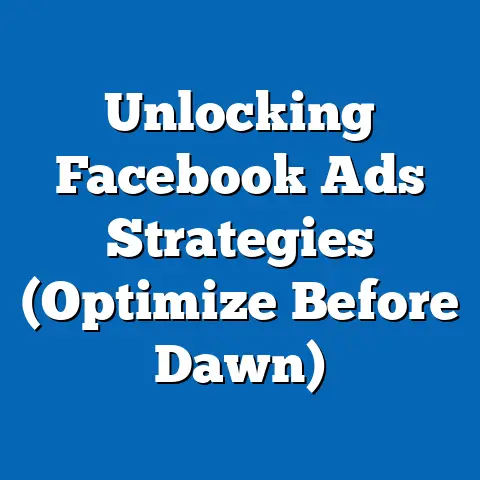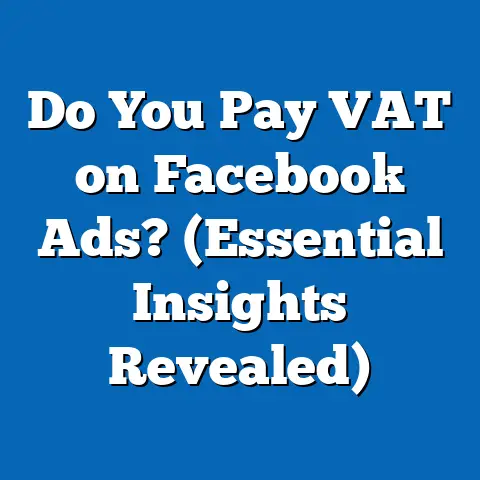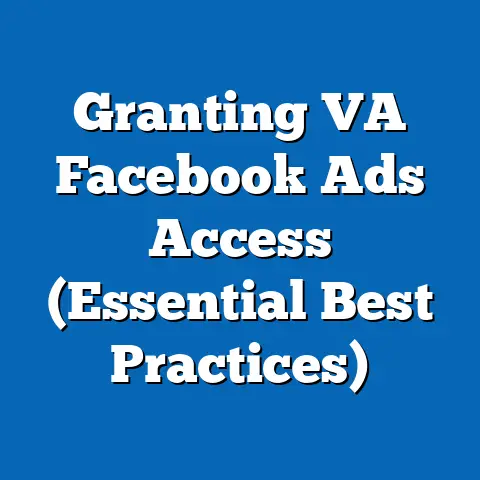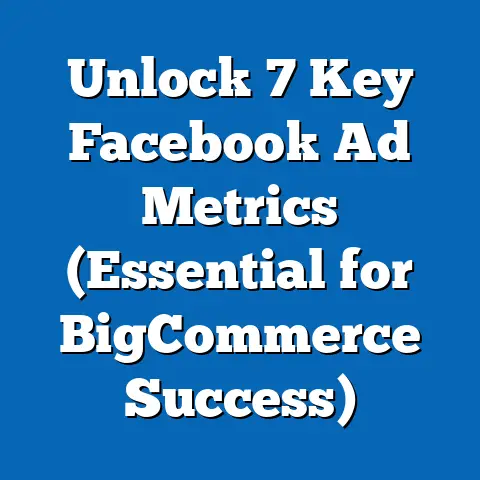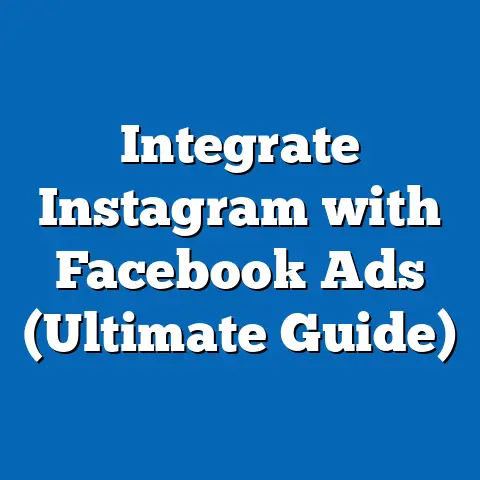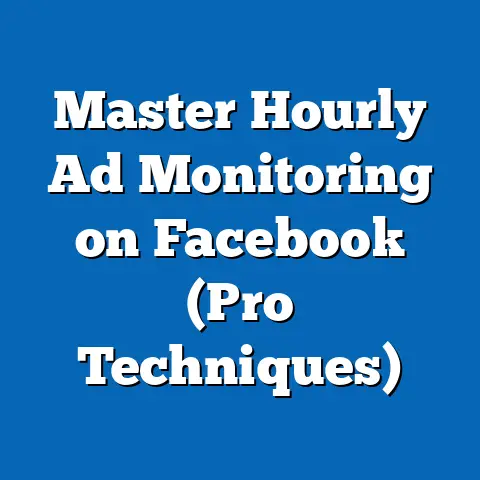Why Facebook Ads Appear on Videos (Uncover Hidden Strategies)
Advertising on Facebook is like being an artist with a vast canvas. But it’s not just about throwing paint and hoping something sticks. It’s about layering – strategically placing elements to create a masterpiece that captivates the audience and drives results. This layering philosophy is particularly evident in how Facebook places ads within video content, aiming to maximize visibility and engagement. I’ve seen firsthand how a well-placed video ad can skyrocket a campaign, but it requires understanding the platform’s dynamics and the psychology behind it. So, let’s dive into why Facebook ads appear on videos and uncover the hidden strategies behind this powerful advertising tool.
The Dynamics of Video Content on Facebook
Video has become the king of content on Facebook. Gone are the days of static images dominating the feed. Now, it’s a constant stream of live videos, short clips, and engaging stories. This shift isn’t just a trend; it’s a fundamental change in how people consume information.
Think about your own Facebook usage. How often do you scroll past text posts and images, only to stop and watch a video? I know I’m guilty of it! The reason is simple: video is more engaging. It combines visual and auditory elements, making it easier to capture attention and convey a message.
Consider these statistics:
- Video generates 1200% more shares than text and images combined. This means videos have a higher potential for organic reach, amplifying your message beyond your immediate audience.
- Users spend 5x longer watching video than reading text. This increased engagement time translates to greater brand recall and message retention.
- 84% of consumers have been convinced to buy a product or service by watching a brand’s video. This highlights the direct impact video can have on conversions and sales.
Facebook’s algorithm recognizes this preference for video. It prioritizes video content in the news feed, meaning videos are more likely to be seen by users. This algorithmic boost is a major advantage for advertisers, as it increases the visibility of their video ads. But it also means that the competition is fierce. You need to create compelling video content that stands out from the crowd to capture your audience’s attention.
Takeaway: Video is the dominant form of content on Facebook, and the algorithm favors it. Advertisers who leverage video ads have a significant advantage in terms of reach and engagement.
Understanding Facebook’s Ad Placement Strategy
Now that we know why video is so important, let’s break down how Facebook places ads within videos. It’s not a random process; it’s a carefully orchestrated strategy designed to maximize impact.
Facebook offers several types of video ad placements:
- In-Stream Ads: These are the ads that play before, during, or after other videos. They’re like commercials on TV, but often shorter and more targeted. I’ve found that these ads work best when they’re highly relevant to the content the user is already watching.
- Feed Ads: These are video ads that appear directly in the user’s news feed, just like organic video content. They’re often designed to blend in seamlessly with the surrounding content, making them less intrusive and more likely to be watched.
- Stories Ads: These are short, vertical video ads that appear between users’ stories. They’re perfect for capturing attention quickly and driving immediate action. I’ve seen brands use Stories ads effectively to promote limited-time offers or events.
- Audience Network: This allows you to extend your video ad reach beyond Facebook to other websites and apps. It’s a great way to reach a wider audience, but it’s important to carefully monitor performance to ensure you’re getting a good return on investment.
Facebook’s algorithm determines which ads to show based on a complex set of factors, including:
- User Data: Facebook collects vast amounts of data about its users, including their demographics, interests, behaviors, and connections. This data is used to target ads to the most relevant audience.
- Ad Relevance: Facebook assesses the relevance of your ad to the user based on factors like the ad’s content, targeting, and landing page. The more relevant your ad, the more likely it is to be shown.
- Bid Amount: The amount you bid for your ad influences its likelihood of being shown. Higher bids generally result in more impressions, but it’s important to balance your bid with your budget and ROI goals.
- Ad Quality: Facebook evaluates the quality of your ad based on factors like its visual appeal, engagement rate, and user feedback. High-quality ads are rewarded with greater visibility and lower costs.
Takeaway: Facebook offers a variety of video ad placements, each with its own strengths and weaknesses. The algorithm uses a complex set of factors to determine which ads to show, emphasizing user data, ad relevance, bid amount, and ad quality.
The Psychology Behind Ad Placement
The effectiveness of video ads on Facebook isn’t just about the technology; it’s also about understanding the psychology of the viewer. Why are ads in videos often more effective than other types of ads? The answer lies in attention spans and strategic placement.
In today’s fast-paced world, attention spans are shorter than ever. People are constantly bombarded with information, making it difficult to capture their attention. Video ads, when done right, can cut through the noise and grab the viewer’s focus.
Here’s how Facebook leverages psychology in its ad placement:
- Strategic Timing: Ads are often placed at moments when viewers are most engaged, such as at the beginning or end of a video, or during a lull in the action. This ensures that the ad is seen when the viewer is most receptive to its message. I’ve noticed that mid-roll ads, while potentially disruptive, can be highly effective if they’re relevant and engaging.
- Visual Storytelling: Video ads have the power to tell stories in a way that static ads cannot. This allows brands to connect with viewers on an emotional level, building trust and loyalty. A well-crafted story can leave a lasting impression, even if the ad is only a few seconds long.
- Seamless Integration: The best video ads are designed to blend in seamlessly with the surrounding content. They don’t feel like intrusive interruptions; instead, they feel like a natural part of the viewing experience. This can be achieved through creative storytelling, high-quality visuals, and relevant messaging.
Takeaway: The effectiveness of video ads on Facebook is rooted in psychology. By understanding attention spans and strategically placing ads, brands can capture viewers’ attention and build meaningful connections.
The Benefits for Advertisers
Utilizing video ads on Facebook offers a multitude of advantages for advertisers. From increased reach and engagement to enhanced brand awareness and higher conversion rates, video ads can be a powerful tool in your marketing arsenal.
Here are some key benefits:
- Increased Reach: As mentioned earlier, Facebook’s algorithm favors video content, meaning video ads are more likely to be seen by users. This increased reach can significantly expand your audience and expose your brand to new potential customers.
- Higher Engagement: Video ads are inherently more engaging than static ads. They capture attention more effectively and hold it for longer, leading to higher engagement rates. This increased engagement can translate to more likes, shares, comments, and website clicks.
- Enhanced Brand Awareness: Video ads can be a powerful tool for building brand awareness. By showcasing your brand’s personality, values, and products in an engaging way, you can create a lasting impression on viewers.
- Improved Conversion Rates: Video ads can directly drive conversions by showcasing your products or services in action. By demonstrating the benefits of your offerings and including a clear call to action, you can encourage viewers to take the next step in the sales funnel.
I’ve seen numerous case studies that demonstrate the effectiveness of video ads. For example, a local restaurant used video ads to promote their new menu items. The ads featured mouthwatering shots of the food, along with testimonials from satisfied customers. As a result, the restaurant saw a 30% increase in reservations and a 20% increase in overall sales.
Takeaway: Video ads offer numerous benefits for advertisers, including increased reach, higher engagement, enhanced brand awareness, and improved conversion rates.
The Algorithmic Advantage
Facebook’s algorithms aren’t just about placing ads; they’re about optimizing them for maximum performance. By understanding how these algorithms work, advertisers can leverage them to their advantage.
Here are some key ways to leverage Facebook’s algorithms for video advertising:
- Targeting: Facebook’s targeting options are incredibly granular, allowing you to reach specific audiences based on demographics, interests, behaviors, and connections. By targeting your video ads to the most relevant audience, you can increase their effectiveness and reduce wasted ad spend. For example, if you’re selling fitness equipment, you can target users who have expressed an interest in fitness, health, and wellness.
- Retargeting: Retargeting allows you to show video ads to users who have previously interacted with your brand, such as visiting your website or watching your videos. This is a highly effective strategy for driving conversions, as these users are already familiar with your brand and are more likely to be interested in your offerings.
- Data Analytics: Facebook provides a wealth of data analytics tools that allow you to track the performance of your video ads. By analyzing this data, you can identify what’s working and what’s not, and make adjustments to your campaigns accordingly. For example, you can track metrics like reach, engagement, video views, and website clicks to assess the effectiveness of your ads.
Takeaway: Facebook’s algorithms can be a powerful tool for optimizing video advertising. By leveraging targeting, retargeting, and data analytics, advertisers can maximize the performance of their campaigns.
Future Trends in Video Advertising on Facebook
The world of video advertising is constantly evolving, and Facebook is at the forefront of this evolution. By staying ahead of the curve and understanding emerging trends, advertisers can position themselves for success in the future.
Here are some key trends to watch:
- Short-Form Video: Short-form video content, such as TikTok videos and Instagram Reels, is becoming increasingly popular. Facebook is responding to this trend by investing heavily in its own short-form video platform, Reels. Advertisers should consider incorporating short-form video into their advertising strategies to reach a younger audience.
- Interactive Video: Interactive video allows viewers to engage with the content in a more meaningful way. This can include features like quizzes, polls, and clickable hotspots. Interactive video ads can be highly engaging and can provide valuable data about viewers’ preferences.
- Augmented Reality (AR) and Virtual Reality (VR): AR and VR technologies are poised to revolutionize the way we experience video content. Facebook is investing heavily in these technologies, and advertisers should consider how they can be used to create immersive and engaging video ad experiences.
I believe that the future of video advertising on Facebook is bright. As technology continues to evolve and user preferences continue to shift, advertisers who are willing to adapt and experiment will be the ones who succeed.
Takeaway: The future of video advertising on Facebook is likely to be shaped by short-form video, interactive video, and AR/VR technologies. Advertisers who embrace these trends will be well-positioned for success.
Embracing the Layered Approach for Success
In conclusion, understanding why Facebook ads appear on videos is about more than just knowing the technical aspects of ad placement. It’s about understanding the layered strategies involved, from the dynamics of video content to the psychology of the viewer. By embracing this layered approach, advertisers can create more effective and engaging video ad campaigns.
I encourage you to think creatively about how you can leverage these insights to improve your own ad campaigns. Experiment with different ad placements, targeting options, and creative approaches. Analyze your results and make adjustments as needed. By continuously learning and adapting, you can master the art of video advertising on Facebook and achieve your marketing goals.
Remember, the key is to foster a deeper connection with your audience through engaging video content. When you do that, you’re not just placing ads; you’re building relationships. And that’s the foundation for long-term success.

